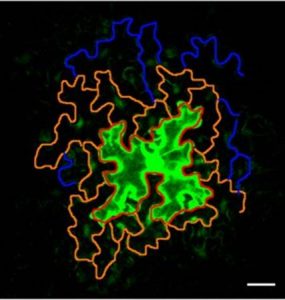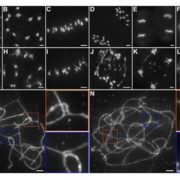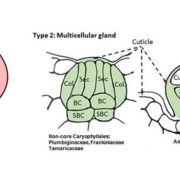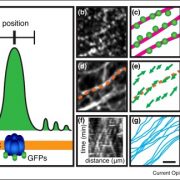Arabidopsis Formin 2 regulates cell-to-cell trafficking through plasmodesmata (eLIFE)
 Plasmodesmata are cell-cell junctions that form cytosolic channels between neighboring plant cells. These junctions mediate the exchange of information between cells during various stress and developmental programs by actively regulating the aperture of the channel entrance or ‘pore’. In a new study published in eLIFE, Diao et al. discovered that the Arabidopsis actin nucleation factor Formin 2 (AtFH2) localizes to plasmodesmata and regulates cell-cell trafficking. The authors show that basal plasmodesmatal pore size/aperture is increased in atfh2 mutants relative to wild-type plants, leading to susceptibility to plant virus infections that rely on plasmodesmatal channels to cause disease. Further biochemical studies demonstrated that AtFH2 binds and caps actin filaments rather than acting as an actin nucleator in vitro. Together, these data support the idea that AtFH2 stabilizes and anchors actin filaments at plasmodesmata to regulate cell-to-cell trafficking in plants. (Summary by Phil Carella) eLIFE 10.7554/eLife.36316
Plasmodesmata are cell-cell junctions that form cytosolic channels between neighboring plant cells. These junctions mediate the exchange of information between cells during various stress and developmental programs by actively regulating the aperture of the channel entrance or ‘pore’. In a new study published in eLIFE, Diao et al. discovered that the Arabidopsis actin nucleation factor Formin 2 (AtFH2) localizes to plasmodesmata and regulates cell-cell trafficking. The authors show that basal plasmodesmatal pore size/aperture is increased in atfh2 mutants relative to wild-type plants, leading to susceptibility to plant virus infections that rely on plasmodesmatal channels to cause disease. Further biochemical studies demonstrated that AtFH2 binds and caps actin filaments rather than acting as an actin nucleator in vitro. Together, these data support the idea that AtFH2 stabilizes and anchors actin filaments at plasmodesmata to regulate cell-to-cell trafficking in plants. (Summary by Phil Carella) eLIFE 10.7554/eLife.36316









